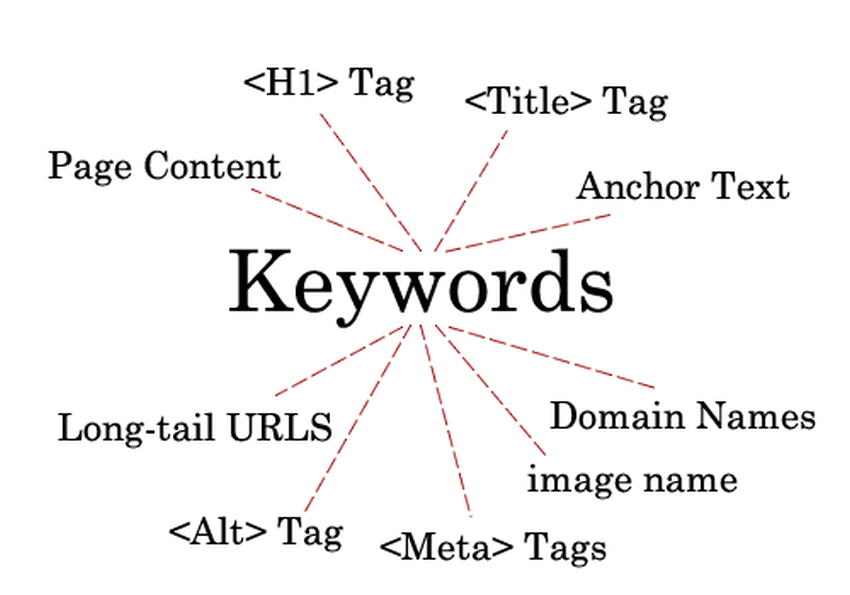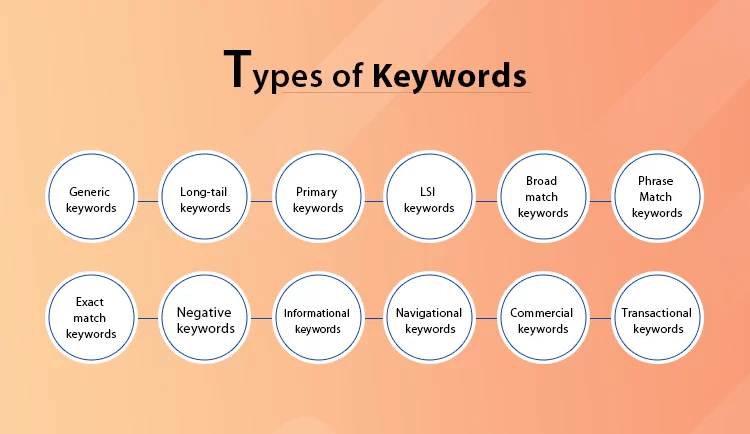Keyword Research Begins with Strategy

What is a keyword?
A keyword is a term or phrase that represents the main idea or subject of a piece of content, document, or a search query. In the context of online content and search engines, keywords play a crucial role in helping users find relevant information. They are used by search engines to match user queries with the most appropriate content, and by content creators to optimize their material for discoverability and search engine ranking.
In essence, a keyword is a word or group of words that encapsulates the central theme of what someone is searching for or what a piece of content is about. Whether used in search engine optimization (SEO), online advertising, or content creation, keywords serve as a bridge between user intent and the content that addresses that intent. They are integral to the way information is organized, accessed, and discovered on the internet.
Why are keywords?
Keywords are specific words or phrases that encapsulate the main topics, themes, or concepts within a piece of content. They serve as a concise representation of the core subject matter and are used for various purposes, particularly in the context of search engines and digital marketing. Here’s why keywords are significant:
- Search Engine Optimization (SEO):
- Keywords are important for SEO, as search engines use them to understand the relevance of web pages to user queries. By strategically incorporating relevant keywords into content, websites aim to improve their visibility in search engine results pages (SERPs).
- User Intent:
- Keywords help match the intent of users’ search queries with the content that best addresses their needs. Understanding user intent is crucial for delivering relevant and valuable information.
- Content Discovery:
- Keywords assist search engines in indexing and categorizing content. When users enter specific keywords in a search engine, the engine retrieves and displays the most relevant content based on those keywords.
- Online Advertising:
- In digital advertising, keywords play a central role in pay-per-click (PPC) campaigns. Advertisers bid on keywords relevant to their products or services, and their ads are displayed when users search for those keywords.
- Content Organization:
- Keywords help organize and structure content. They guide content creators in creating headings, subheadings, and meta tags, contributing to a well-organized and easily understandable piece of content.
- Audience Targeting:
- Through keyword research, businesses can identify the terms and phrases their target audience commonly uses. This understanding enables more effective communication and engagement with the intended demographic.
- Competitive Analysis:
- Analyzing the keywords that competitors are targeting provides insights into industry trends, customer preferences, and effective SEO strategies. This information can inform a business’s own keyword strategy.
- Effective Communication:
- Keywords help in articulating the central themes of a piece of content. They serve as a concise representation of the broader concepts, making it easier for both search engines and users to understand the content’s focus.
- Measuring Performance:
- In digital marketing, keywords are used to assess the performance of campaigns. Metrics such as click-through rates, conversion rates, and keyword ranking positions provide valuable data for optimizing marketing strategies.
- Adaptation to Search Algorithms:
- As search engine algorithms evolve, keywords continue to be relevant, but modern algorithms increasingly consider factors beyond exact keyword matches. They now assess content quality, user engagement, and contextual relevance.
Why are Keywords Important?
Keywords are important in online content because they serve as the bridge between user intent and search engine results. By strategically incorporating relevant keywords, content creators enhance their chances of visibility in search engine rankings. This visibility not only attracts targeted traffic but also aligns content with what users are actively seeking. Keywords form the backbone of effective Search Engine Optimization (SEO), guiding search engines to understand and rank content appropriately. In essence, they facilitate the connection between your content and the queries of your audience, making keywords an indispensable element in the digital landscape for improving online presence and reaching the right audience.
1. Connecting with Your Audience:
- Keywords serve as the language of search engines and users alike. When someone types a query into a search engine, they use specific words or phrases to find information. By incorporating relevant keywords into your content, you’re essentially speaking the same language as your audience. This connection improves the chances of your content being discovered by those actively seeking what you have to offer.
2. Navigating the SEO Landscape:
- In the dynamic world of SEO, keywords act as navigational tools for search engines. When you strategically choose and implement keywords in your content, you provide search engines with clear signals about the topics your content covers. This, in turn, helps search engines index and rank your pages appropriately, ensuring they appear in relevant search results.
3. improve Content Relevance:
- The heart of SEO lies in delivering relevant and valuable content to users. Keywords play a pivotal role in ensuring that your content aligns with the interests and needs of your target audience. By conducting thorough keyword research, you gain insights into the phrases your audience uses, allowing you to tailor your content to meet their expectations.
4. Improving Search Engine Rankings:
- The competition for attention on the internet is fierce. Effective use of keywords can give your content a competitive edge. Search engines assess the relevance of content based on the presence of keywords. By optimizing your content with the right keywords, you increase the likelihood of your pages ranking higher in search engine results, driving more organic traffic to your site.
5. Strategic Content Organization:
- Keywords serve as a roadmap for organizing your content. They guide you in creating clear and structured information that is easy for both users and search engines to understand. Properly organized content, with keywords strategically placed in headings and throughout the text, enhances the overall user experience and contributes to better SEO performance.
6. Adapting to User Intent:
- Understanding user intent is a cornerstone of successful SEO. Keywords are key indicators of what users are searching for and what they hope to find. By aligning your content with the intent behind specific keywords, you not only attract more visitors to your site but also provide them with the information they are actively seeking.
7. Measuring and Refining Strategies:
- Keywords offer a measurable metric for assessing the performance of your SEO strategies. Monitoring the performance of selected keywords, analyzing click-through rates, and tracking keyword ranking positions provide valuable data. This data, in turn, enables you to refine your SEO approach, ensuring continuous improvement and adaptability in the ever-evolving digital landscape.

How to Use Keywords?
Using keywords effectively is crucial for optimizing your online content, whether it’s a blog, website, or any other digital platform. Here’s a step-by-step guide on how to use keywords to improve your search engine optimization (SEO) and connect with your target audience:
- Conduct Keyword Research:
-
- Start by identifying relevant keywords for your content. Use tools like Google Keyword Planner, SEMrush, or Ahrefs to discover keywords related to your topic. Consider long-tail keywords that reflect specific phrases your audience might use.
- Understand User Intent:
-
- Go beyond the keywords themselves and understand the intent behind them. Consider what your target audience is looking for when they use those keywords. This insight will guide your content creation.
- Place Keywords Strategically:
-
- Integrate keywords strategically throughout your content. Place them in:
-
-
- Title: Include the main keyword in the title for better visibility.
- Headings and Subheadings: Use keywords naturally in headings to structure your content.
- First Paragraph: Incorporate the main keyword early in the content.
- Body Text: Sprinkle related keywords naturally throughout the text.
- Meta Tags: Include keywords in meta titles and meta descriptions.
-
- Maintain Readability and Relevance:
-
- While incorporating keywords, prioritize the readability and relevance of your content. Ensure that your writing flows naturally and provides value to your audience. Avoid keyword stuffing, which can harm your SEO and user experience.
- Create High-Quality Content:
-
- Keywords should complement high-quality, engaging content. Write content that answers questions, provides solutions, or offers valuable insights. Search engines increasingly prioritize content that satisfies user intent.
- Optimize Images and Multimedia:
-
- Include keywords in image alt text and file names. This not only helps search engines understand the content of your images but also contributes to overall SEO.
- Use Internal and External Links:
-
- Incorporate relevant keywords into anchor text when linking to other pages on your site (internal links) or external authoritative sources. This enhances the context and SEO value of the linked pages.
- Consider Mobile Optimization:
-
- With the rise of mobile searches, ensure your keywords are optimized for mobile users. Mobile-friendly content is favored by search engines.
- Regularly Update and Refresh Content:
-
- Keep your content up-to-date and relevant. Periodically revisit and update older content with new keywords or information. Search engines favor fresh, valuable content.
- Monitor Performance and Adjust:
-
- Use tools like Google Analytics or Search Console to monitor the performance of your keywords. Analyze data such as click-through rates, rankings, and user engagement. Adjust your keyword strategy based on performance insights.
- Consider Long-Term SEO Goals:
-
- SEO is a long-term strategy. While short-term gains are possible, consistent and ethical use of keywords over time contributes to sustained visibility and audience growth.
- Adapt to Algorithm Changes:
-
- Stay informed about changes in search engine algorithms. Search engines regularly update their algorithms, and adapting your keyword strategy to align with these changes is crucial for ongoing success.
How to Find Keywords for SEO?
Finding keywords for SEO is important for improving your website’s visibility and attracting the right audience. Here’s a brief guide on how to discover relevant keywords:
1. Understand Your Niche and Audience:
- Start by understanding your industry, niche, or the topic of your content. Consider the language your target audience uses and the specific terms they might search for.
2. Brainstorm Relevant Topics:
- Generate a list of topics related to your niche. What are the main themes and subjects you want to cover? These will serve as the foundation for identifying relevant keywords.
3. Use Keyword Research Tools:
Popular Tools
- Google Keyword Planner: Provides insights into search volume, competition, and suggested bid prices for keywords.
- SEMrush: Offers comprehensive keyword research and competitor analysis.
- Ahrefs: Helps in finding keywords, analyzing backlinks, and exploring content opportunities.
- Explore Long-Tail Keywords: Long-tail keywords are specific, longer phrases that address a particular query. They often have less competition and can be valuable for targeting a more focused audience. For example, instead of “running shoes,” consider “best running shoes for beginners.”
5. Analyze Competitor Keywords:
- Analyze the keywords your competitors are targeting. Tools like SEMrush and Ahrefs can provide insights into the keywords for which your competitors are ranking. Identify gaps and opportunities in your keyword strategy.
6. Use Google Autocomplete and Related Searches:
- Leverage Google’s autocomplete feature by typing your main topic into the search bar. Take note of the suggested searches, as they often represent common queries. Similarly, scroll to the bottom of the search results page to find related searches.
7. Check Google Trends:
- Google Trends provides information on the popularity of search queries over time. It can help you identify trending topics and seasonal keywords. Compare different keywords to see which ones are currently more popular.
8. Utilize Social Media and Forums:
- Monitor social media platforms and relevant forums to understand the language your audience uses. Discussions and comments can provide insights into common questions and concerns.
9. Consider Intent:
- Think about the intent behind the search. Are users looking for information, products, reviews, or solutions?
- Tailor your keywords to align with user intent.
10. Create a Seed List:
- Compile a seed list of potential keywords based on your brainstorming, research, and analysis. This list will serve as a starting point for further refinement.
11. Evaluate Keyword Difficulty:
- Assess the difficulty of ranking for specific keywords. Keyword difficulty indicates how challenging it is to compete for a particular keyword. Choose a mix of high and low difficulty keywords based on your website’s authority.
12. Refine and Expand Your List:
- Refine your list by removing irrelevant or overly competitive keywords. Expand it by considering variations, synonyms, and related terms.
13. Organize Keywords:
- Categorize your keywords based on relevance and intent. This organization will help in creating targeted content and optimizing different sections of your website.
14. Prioritize and Plan:
- Prioritize your keywords based on factors such as search volume, relevance, and business goals. Develop a plan for incorporating these keywords into your content strategy.

Types of Keywords
1. Short-Tail Keywords:
- Definition: Short and general keyword phrases, usually consisting of one to three words.
- Example: “shoes,” “travel,” “fitness.”
- Use Case: Attracts a broad audience but tends to have high competition.
2. Long-Tail Keywords:
- Definition: Longer and more specific keyword phrases, often containing three or more words.
- Example: “best running shoes for beginners,” “healthy vegetarian recipes for dinner.”
- Use Case: Targets a more specific audience with potentially lower competition.
3. LSI Keywords (Latent Semantic Indexing):
- Definition: Words or phrases related to the main keyword, providing context and depth to the content.
- Example: For “apple,” LSI keywords could include “fruit,” “orchard,” or “health benefits.”
- Use Case: Enhances content relevance and helps search engines understand context.
4. Commercial Intent Keywords:
- Definition: Keywords indicating an intent to purchase a product or service.
- Example: “buy running shoes online,” “discounted travel packages.”
- Use Case: Valuable for e-commerce websites and businesses focused on conversions.
5. Informational Keywords:
- Definition: Keywords used to gather information on a specific topic.
- Example: “how to tie a tie,” “benefits of yoga.”
- Use Case: Targets users seeking knowledge, often used in blog posts and educational content.
6. Navigational Keywords:
- Definition: Keywords used to find a particular website or page.
- Example: “Facebook login,” “Nike official website.”
- Use Case: Important for brand recognition and directing users to specific destinations.
7. Transactional Keywords:
- Definition: Keywords indicating an intent to perform an online transaction.
- Example: “book a flight,” “sign up for a webinar.”
- Use Case: Relevant for businesses offering services or products with a clear call to action.
8. Brand Keywords:
- Definition: Keywords specific to a particular brand or company.
- Example: “Apple iPhone,” “Nike sneakers.”
- Use Case: Important for brand visibility and attracting users already familiar with a brand.
9. Geo-Targeted Keywords:
- Definition: Keywords including a specific location or region.
- Example: “restaurants in New York,” “plumber near me.”
- Use Case: Useful for businesses targeting local audiences or providing location-specific services.
10. Seasonal Keywords:
- Definition: Keywords related to specific seasons, holidays, or events.
- Example: “summer fashion trends,” “Christmas gift ideas.”
- Use Case: Ideal for time-sensitive promotions and content.
11. Product Keywords:
- Definition: Keywords specifically related to a product.
- Example: “iPhone 13 review,” “best running shoes for women.”
- Use Case: Essential for e-commerce sites and product-focused content.
12. Industry-Specific Keywords:
- Definition: Keywords tailored to a particular industry or niche.
- Example: “digital marketing strategies,” “blockchain technology.”
- Use Case: Targets a specialized audience within a specific field.
13. Action Keywords:
- Definition: Keywords that encourage users to take a specific action.
- Example: “download free ebook,” “subscribe to newsletter.”
- Use Case: Drives engagement and conversions.
14. Competitor Keywords:
- Definition: Keywords related to competitors’ brands or products.
- Example: “alternative to [competitor brand],” “[competitor] vs [your brand].”
- Use Case: Targets users considering or comparing similar products or services.
15. DIY Keywords (Do It Yourself):
- Definition: Keywords indicating a user’s intent to learn or perform a task independently.
- Example: “DIY home decor ideas,” “how to bake a cake from scratch.”
- Use Case: Relevant for instructional and tutorial content.
16. Problem-Solving Keywords:
- Definition: Keywords related to addressing specific issues or challenges.
- Example: “fix a leaky faucet,” “reduce stress tips.”
- Use Case: Targets users actively seeking solutions to problems.
17. Tutorial Keywords:
- Definition: Keywords indicating a user’s interest in step-by-step guides or tutorials.
- Example: “Photoshop tutorial for beginners,” “learn to play guitar.”
- Use Case: Ideal for creating instructional and educational content.
18. Comparison Keywords:
- Definition: Keywords used when users are comparing different options.
- Example: “[product] vs [alternative],” “best budget smartphones 2023.”
- Use Case: Valuable for content that helps users make informed decisions.
19. Evergreen Keywords:
- Definition: Keywords that remain relevant over an extended period.
- Example: “healthy eating tips,” “basic photography techniques.”
- Use Case: Suitable for creating timeless content with lasting value.
20. Conversational Keywords:
- Definition: Keywords reflecting natural language and conversational queries.
- Example: “What are the best exercises for weight loss?” “How does solar energy work?”
- Use Case: Aligns with the growing popularity of voice search and natural language queries.

Qualities of a Keyword
Introduction:
In the dynamic zone of Search Engine Optimization (SEO), keywords stand as the fundament of visibility, connecting users with relevant content. Understanding the nuanced qualities of a keyword is paramount for crafting an effective SEO strategy. In this blog post, we explore four important qualities that define a keyword’s impact: Search Volume, Competition, Price (Cost-Per-Click), and Word Count.
1. Search Volume:
- Defined Essence: Search volume encapsulates the frequency with which users search for a specific keyword. It’s the heartbeat of discoverability.
- Significance: High search volume indicates a broader audience but may entail higher competition. Low search volume may bring targeted traffic but could limit overall visibility.
- Optimization Insight: Striking a balance aligns content with popular queries while avoiding excessive competition.
2. Competition:
- Defined Essence: Competition gauges the number of websites vying for visibility using a particular keyword. It’s the arena where relevance meets rivalry.
- Significance: High competition demands strategic optimization to outshine rivals. Low competition offers potential for easier ranking but may suggest a niche with limited interest.
- Optimization Insight: A strategic blend involves selecting keywords that align with content relevance and navigable competition levels.
3. Price (Cost-Per-Click):
- Defined Essence: In the realm of paid advertising, the cost-per-click (CPC) signifies the price advertisers are willing to pay for each click on their ad triggered by a specific keyword.
- Significance: Higher CPC often indicates a keyword’s perceived value for conversions. Lower CPC may suggest untapped potential or less competitive markets.
- Optimization Insight: Balancing organic and paid strategies involves understanding the value of keywords in both realms.
4. Word Count:
- Defined Essence: The word count of a keyword refers to the number of words in a specific search query. It’s the syntax that defines user intent.
- Significance: Short-tail keywords offer brevity but may lack specificity. Long-tail keywords provide depth but might attract a narrower audience.
- Optimization Insight: Crafting content that aligns with both short-tail and long-tail keywords ensures a holistic approach to user intent.
Crafting an SEO-Friendly Blog:
Introduction to Keywords:
- Engage the Audience: Open with a compelling introduction on the pivotal role keywords play in connecting users with desired content.
- Highlight Significance: Emphasize the impact of well-chosen keywords on search engine rankings and overall online visibility.
Deep Dive into Qualities:
- Search Volume Insights: Delve into the intricacies of search volume, providing insights into the delicate balance between broad reach and targeted engagement.
- Navigating Competition: Guide readers through the competitive landscape, offering strategies for selecting keywords that align with their content and SEO goals.
- Unlocking CPC Secrets: Unveil the world of paid advertising, shedding light on how CPC reflects the perceived value of keywords and its integration with overall SEO strategies.
- Decoding Word Count Dynamics: Explore the nuances of word count in keywords, empowering readers to craft content that resonates with varied user intents.
Optimization Strategies:
- Strategic Keyword Selection: Offer practical tips on strategically selecting keywords based on the interplay of search volume, competition, CPC, and word count.
- Content Crafting Techniques: Provide actionable insights into crafting content that seamlessly integrates both short-tail and long-tail keywords for a comprehensive approach.
Adaptability and Future Trends:
- Dynamic Nature of SEO: Emphasize the dynamic nature of SEO, encouraging readers to stay informed about industry trends, user behavior, and evolving search engine algorithms.
- Continuous Optimization: Conclude by stressing the importance of continuous optimization, urging readers to adapt their keyword strategies to maintain relevance and visibility.


I do trust all the ideas youve presented in your post They are really convincing and will definitely work Nonetheless the posts are too short for newbies May just you please lengthen them a bit from next time Thank you for the post
Thank you for the thoughts you gave by reading our blog. we will definitely work on it
Excellent blog here Also your website loads up very fast What web host are you using Can I get your affiliate link to your host I wish my web site loaded up as quickly as yours lol
Thanks for reading our blog. Whatever problem you may have, we will present it to you for improvement.